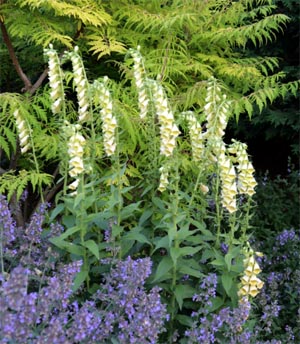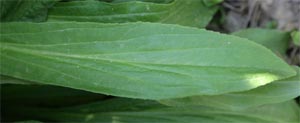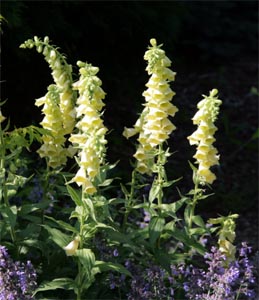
Yellow foxglove, Digitalis grandiflora (= D. ambigua and D. orientalis), is a short-lived, clump-forming perennial native to woods and stream banks from central Europe to Turkey and Siberia, hardy in zones 3-8. It isn’t as showy as the more common D. purpurea with its purple or white flowers. Foxgloves are in a genus of about 20 species of mainly biennials in the family Scrophulariaceae (or more recently moved to the family Plantaginaceae).

The soft, lush foliage is only 12-18” tall but the flower spikes will grow to 3 feet tall. The 5-10” long, deep green leaves are lance-shaped with fine teeth on the edges and prominent veins. They are produced in basal rosettes. Smaller leaves are produced alternately up the stems.
The 1-2” tubular flowers are pale yellow, spotted or netted brown inside. Each flower somewhat resembles the snipped off-finger of a glove. The pendulous flowers are born in upright terminal racemes (spikes) up to a foot long in mid- to late summer. They occur on one side of the leafy, 2-3 foot tall stems. It makes a good cut flower if picked when the blooms are half open.


Yellow foxglove is a nice addition to lightly shaded woodland gardens, informal borders, and cottage gardens. D. grandiflora looks right at home naturalized along the edge of a wooded area. The plants are a dramatic vertical accent when in flower, especially when viewed against a dark background such as provided by shrubs or buildings. The soft yellow flowers blend with both hot and cool colors, so fit with most color schemes. It combines well with bright oriental poppies, purple- or blue-flowered perennials such as catmint (Nepeta), or the chartreuse of lady’s mantle (Alchemilla mollis). In shadier spots try it with astilbe, hostas, or coral bells (Heuchera).
Yellow foxglove is easy to grow in almost any type of soil except for very wet or very dry, although it prefers moist, well-drained, fertile soil. Once established it is relatively drought tolerant. Plant it in full sun or partial shade. Enrich the soil with compost or other organic matter before planting. Remove the flower stalks after the flowers fade to promote rebloom or improve the appearance of the plant (but leave some if you wish them to self-sow). The foliage tends to be evergreen, so do not cut back in fall, but you can cut back any remaining flower stems down to the base. Prune off winter-damaged leaves in spring. Foxgloves have few pests and are not favored by deer or rabbits but may develop mildew or leaf spots.
Individual plants generally only live for 4 or 5 years. Yellow foxglove is easy to propagate from seed and it often self-seeds under favorable conditions (but is not invasive). If you want to start seed indoor, sow at 65-70ºF in early spring. Do not cover seeds as light aids germination. Seeds should begin germinating in 2-4 weeks. Transplant the seedlings into larger pots when they are large enough to handle. As with any transplants, harden off before planting in the ground about 12” apart. Alternately, sow seeds in pots or flats outdoors in fall to germinate in early spring. Yellow foxglove does not transplant easily when mature, so it’s best to move the plants while they are still small. Plants can also be divided in spring or fall, separating new sections from the crown.

There are only a few varieties of yellow foxglove:
- ‘Carillon’ is a dwarf selection that grows only 1 foot tall and has smaller yellow flowers. It often blooms the first year, but may act more as an annual or biennial than perennial.
- ‘Temple Bells’ is a larger flowering selection.
- Digitalis x grandiflora ‘John Innes Tetra’ is a hybrid between D. lanata and D. grandiflora with rose colored flowers.
As with other members of the genus, this plant contains compounds that have been used medicinally (historically and in more recent medical applications) but ingestion can be toxic and is not recommended.
– Susan Mahr, University of Wisconsin – Madison





 Marigolds
Marigolds Create a Butterfly Garden
Create a Butterfly Garden Plant Flowers to Encourage Beneficial Insects
Plant Flowers to Encourage Beneficial Insects Forcing Bulbs
Forcing Bulbs


